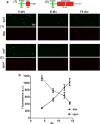Independent vesicle pools underlie different modes of release during neuronal development
- PMID: 22302825
- PMCID: PMC6703344
- DOI: 10.1523/JNEUROSCI.5181-11.2012
Independent vesicle pools underlie different modes of release during neuronal development
Abstract
Mature presynaptic terminals release neurotransmitter both in response to activity and spontaneously. We found that axons of rat hippocampal neurons initially show very high levels of exclusively spontaneous release, which progressively switches over to the mature phenotype during synapse formation. These two modes of vesicle cycling derive from distinct pools throughout development and the initiation of activity-dependent release was independent of postsynaptic contacts, suggesting it is an autonomous presynaptic event.
Figures




References
Publication types
MeSH terms
Grants and funding
LinkOut - more resources
Full Text Sources
Other Literature Sources
